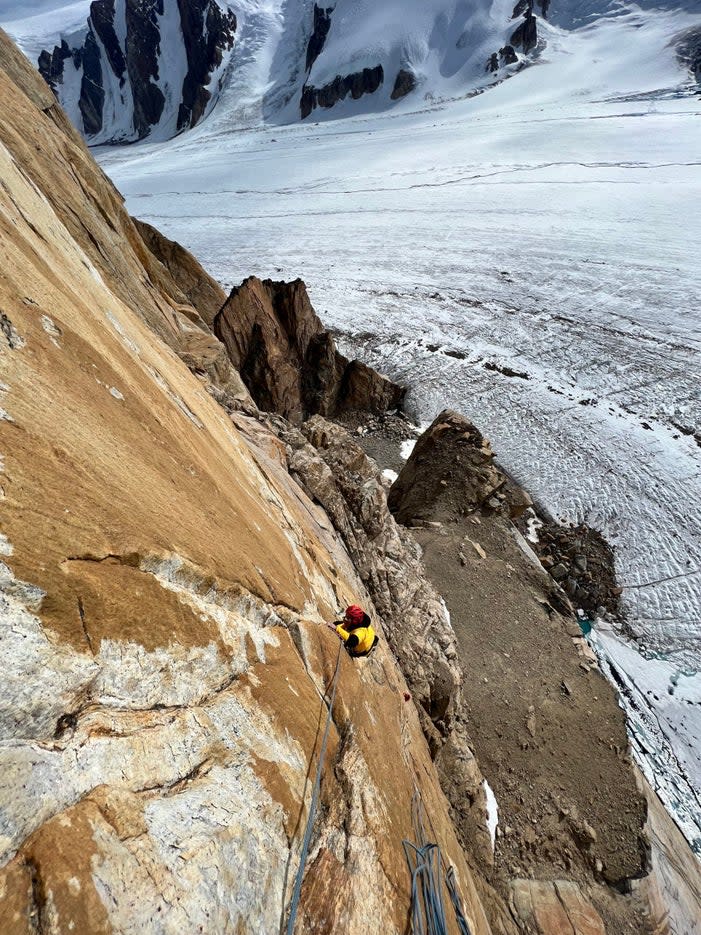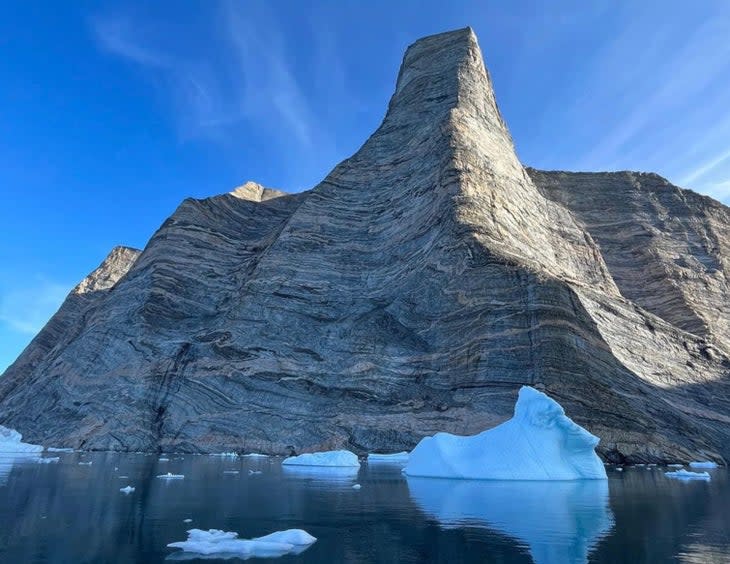Hazel Findlay, Alex Honnold Establish Two Serious Walls in Greenland
- Oops!Something went wrong.Please try again later.
- Oops!Something went wrong.Please try again later.
This article originally appeared on Climbing
Hazel Findlay and Alex Honnold have just returned from a busy six weeks of new routing and data-gathering in Greenland, where they climbed, among other things, the first ascent of Ingmikortilaq (3,750 feet) by its north face.
The trip began with a "very long approach" to the base of their first unclimbed objective: the Pool Wall. "We established a 1,500-foot 5.12c straight up the center which we named Two Ravens," Honnold wrote to Climbing in an email. "The wall was gneiss, which was interesting because we’d thought that it would be granite, and required a fair amount of face climbing to connect between various crack systems." Findlay (also writing via email) said Two Ravens had several loose pitches but some great ones too. "We made the route nice, with bolted belays and some bolts on the runouts. Alex and I both free climbed every pitch in a two-day push," she said.
Findlay had a standout performance on their second day, Honnold later wrote on social media, while a ripping Arctic breeze blasted the Pool Wall: "It was definitely below freezing temps, with an icy wind, and she left the portaledge to go clean a terribly rotten finger crack so that we'd be able to free it. She spent over an hour dangling in [the] freezing wind working it out and then led the pitch with no complaints. I was so glad to top rope it. And so grateful to have a strong partner who could take some of the unpleasant leads."

Mikey Schaefer, a legendary bigwaller and filmmaker, and Aldo Kane helped establish Two Ravens by bolting, hauling, fixing lines, and, in Schaefer's case, pushing the rope higher. The French scientist Heidi Sevestre and guide Adam Kjeldsen jumared behind the team and collected rock core samples to help climate-change scientists understand what Greenland's climate looked like during the previous ice age (when those same rocks were under ice).
Findlay later remarked that her ascent of the Pool Wall was the first time she hadn't immediately done two things after climbing a big wall, "eaten a huge, quality meal and taken a long, hot shower." Indeed, the best was yet to come: after five days of ferrying equipment (including a radar to measure depth and density of the ice) across the Renland Ice Cap, they reached their main objective, the sweeping north face of Ingmikortilaq.

Ingmikortilaq, like the Pool Wall, was also gneiss, but much more "broken and jumbled," Honnold said, requiring many pitches of serious, runout face climbing. "The bottom 2,000 feet were also lower angle than expected and covered in scree and loose blocks--it all made for very engaging climbing." Findlay, Honnold, Schaefer, and Kane climbed as a group for the first four days, establishing the new terrain and hauling loads, before Findlay and Honnold cast off as a pair to avoid trundling rocks onto the rest of the team. Findlay attributed most of the ascent's dangerous moments to rock or ice fall, a symptom of the three-million-year-old rock's freeze-thaw cycles.
"Ultimately, we climbed the left skyline of the tower, which we called the North East Ridge, mostly because it felt more like a mountain climb than a climbing 'route,'" Honnold said. "Hazel called it E6, in British grades, and I think that it was 5.11- X in American grades, though it defies grading to some extent because it would be almost impossible for someone to follow the exact same route."

The climbers had a science objective for Ingmikortilaq, too: they drilled temperature sensors into the wall so future scientists can monitor and analyze temperature change in this remote part of the world. "So much data collection is done from satellite and plane imagery," Findlay explained, "it's hard for scientists to get ground data--especially from huge walls. It was pretty cool to use our skills as climbers to collect data."
While this Greenland expedition ticked all the satisfaction boxes for Honnold (impressive walls, remote terrain, a great team, "a bunch of good books"), he acknowledged just how challenging the six weeks were at times: "It was some of the coldest rock climbing I've ever done, and some of the worst climbing conditions (rain and snow). So it's not like it was all physically comfortable. But it was worth it."
Anthony Walsh is a digital editor at Climbing.
For exclusive access to all of our fitness, gear, adventure, and travel stories, plus discounts on trips, events, and gear, sign up for Outside+ today.

